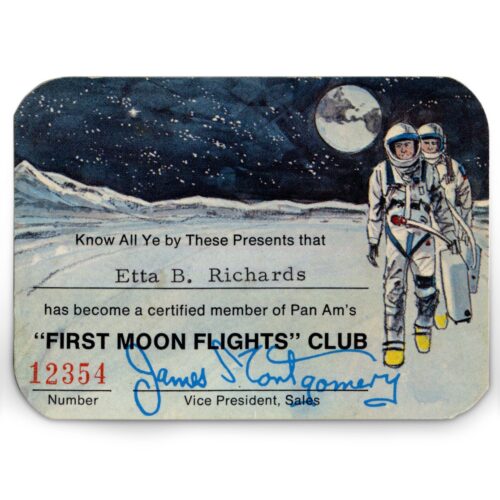
It was a scrolling sort of day. And an educational one. Here’s what we learned today about the Concorde, Janet Bragg, and Pan Am’s “First Moon Flights” Club.
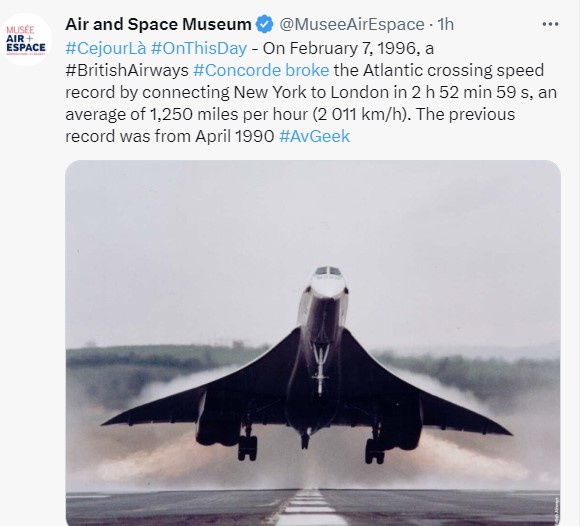

It was a scrolling sort of day. And an educational one. Here’s what we learned today about the Concorde, Janet Bragg, and Pan Am’s “First Moon Flights” Club.

While visiting the Allied Museum in Berlin this past July just days before the opening of a new exhibition about the American era at Temphelhof Airport, I had the pleasure of meeting Natascha Bonnermann, the woman who brought a Cold War-era lounge for Pan Am employees back to life.
Here’s the story of the lounge I put together for the Runway Girl Network:
As time capsules go, Berlin’s Pan Am Lounge is a charmer. And a Cold War relic.
Located on the 10th floor penthouse of the Eden Haus apartment building overlooking the Berlin Zoological Garden and what is now a very upscale neighborhood, the lounge once served as a private gathering spot for flight attendants and pilots who worked for Pan American World Airways, which established offices in a building nearby in the mid-1960s.
During the Cold War, which stretched from 1945 to 1990, no German airlines were allowed to use the Berlin air corridors and West Berlin was served by Pan Am, British Airways and Air France, airlines representing the Western allies.
“The rooftop lounge was furnished for the amusement and distraction of pilots and stewardesses, many of whom also had apartments below,” said Natascha Bonnermann, the actress who resurrected the lounge as an exclusive event and party venue after finding it abandoned in 2005.
“The Cold War ended, Pan Am went out of business and the lounge was forgotten because the employees went home,” said Bonnermann during a recent tour of the lounge. “It was used so seldom that the rest of the world didn’t think of it anymore. It was simply forgotten.”
Well, not quite. A former Pan Am flight attendant held an annual party in the lounge and a former DJ from Armed Forces Radio had his own key to the lounge and would go up there to play cards with his buddies.
Bonnermann learned about the lounge through a chance meeting with the DJ and discovered that the retreat, decorated in what’s been described as a “James Bond and Aspen-chic aesthetic,” was still intact and that, over the years, the panorama view from the outdoor terrace, had gotten even better.
“Inside it was exactly as you see it now,” Bonnerman said on our tour, “The bar, the dance floor and all the original furniture, everything was still here. Even the ashtrays.”
Bonnermann set aside her acting career to revive the lounge as retro-swank event venue where guests are greeted and served by wait staff wearing uniforms based on those worn by Pan Am crew in 1964.
The wood on the tiny dance floor has been refinished, the mural depicting the Boston Tea Party has been cleaned, specialists have restored the leather on the chairs and a few technical improvements have been made to the sound system, but strict attention has been paid to keeping the lounge exactly as it was.
“It’s a proof of the time and that era and you can’t mess around with it,” said Bonnermann. “I don’t want to adjust it to our tastes now.”
Pilots, flight attendants and guests who frequented the lounge back in the day are “are overwhelmed with emotions and the flood of memories” when they return to visit, said Bonnermann. And while they confirm that the lounge looks just as it did before, “they are all extremely discreet about what happened here,” she said.
Dreaming of a trip to Hawaii?
So, evidently, are the curators at the Smithsonian’s National Air and Space Museum in Washington, D.C.
They’ve put together “Hawaii by Air,” an exhibition featuring Hawaiian travel posters, photographs and ephemera that explores how air travel to Hawaii developed and grew, how the travel experience evolved along with the airplane and how air travel changed Hawaii.
Also on display: airplane models, airline uniform badges, historic film footage, a high-resolution satellite image of the islands, broadcasts from a vintage Hawaiian radio show and live Hawaiian plants.
Hawaii, exhibition notes remind us, is one of the most remote places on Earth. It got its first air service in 1935 and, by 1936 Pan American Airways was delivering passengers on its famous flying clipper ships.
From the exhibition notes:
“Flying to Hawaii was luxurious but expensive; most people still traveled by ocean liner. That changed after World War II, when new propeller-driven airliners and then jets made travel to this remote destination much more common, comfortable and affordable. Hawaii experienced a tourism boom that exceeded all expectations.”
The exhibit runs through July 2015.
It’s Souvenir Sunday – when we take a a look at some of the souvenirs you can pick up when you’re stuck at the airport.
This week’s souvenirs come from San Francisco International Airport, where the Brookstone store has modern-day versions of Pan Am travel items;
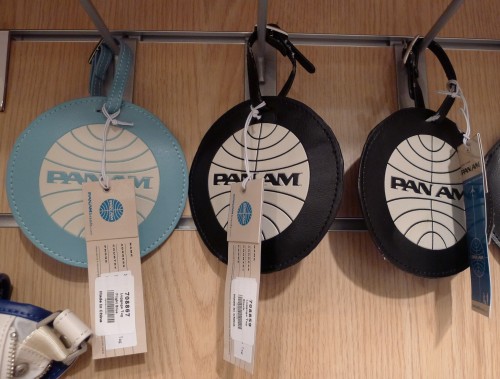
Where several newsstands carry flight attendant-themed doll sets;
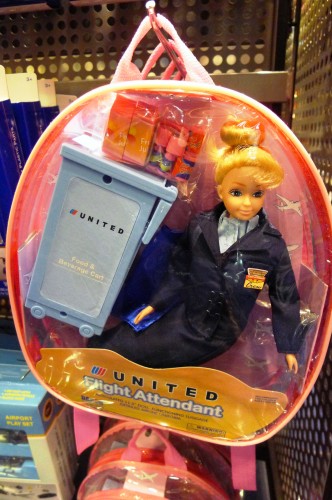
And where a new shop called Destination Green offers these cute pink (‘green’) cars that Barbie might covet.
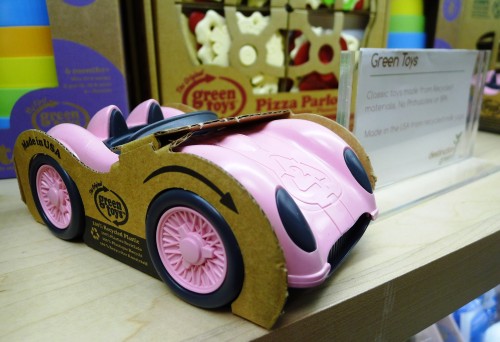
If you watched the Sunday night premiere of “Pan Am,” you might be wondering if the idyllic version of 1960s air travel matches the reality of those who worked for the iconic airline.
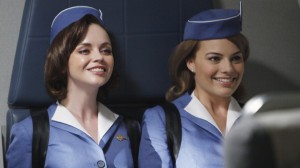
Msnbc.com’s Overhead Bin wondered, too. So I asked two former Pan Am flight attendants to watch the show and tell me if their experiences were anything like those portrayed on-screen.
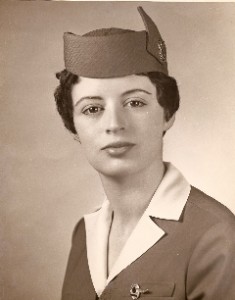
Bronwen Roberts in a 1958 Pan Am graduation photo.
Bronwen Roberts was hired at Pan Am in 1958 shortly after graduating England’s University of Leeds with a degree in French. She flew until 1989 and kept in a scrapbook the advertisement listing the 15 qualifications required of flight attendant applicants. “You had to have a pleasant personality and speaking voice, excellent health and you had to be single,” said Roberts. “Really single. Not widowed, divorced or separated.”
A weight between 110 and 135 pounds was another qualification. Roberts said the pre-flight weigh-ins and grooming inspections depicted on the show were true-to-life.
“When you checked in for a flight you’d go into the office and there’d be a grooming supervisor on duty all the time,” said Roberts. “She could say, ‘Your hair is too long’ or ‘You are overweight’ and send you home until you fixed it. Just like the TV show, you could get grounded for uniform violations.”
Helen Davey also found the on-screen grooming checks familiar. Now a psychotherapist in Los Angeles, she was hired as a Pan Am flight attendant in 1965 at age 21 and flew until 1986.
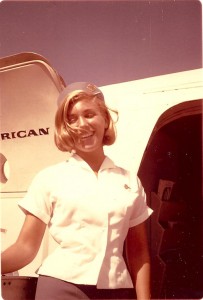
Helen Davey in an undated photo from her days as a Pan Am flight attendant.
“Yes, we had to wear girdles,” said Davey. “And if you were one minute late for a trip, they’d send you home.”
In the first episode, a child is escorted into the cockpit mid-flight to visit the pilots. Passengers are also offered ashtrays so they can smoke. Roberts and Davey both said that those in-flight activities were once very common.
“We definitely took children into the cockpit so they could sit in the pilot’s seat,” said Roberts. “And in terms of smoking, we’d have little packets of cigarettes and matches that we’d go around with.”
“Even flight attendants could smoke,” added Davey. “But when they did, they had to be sitting down.”
In the episode (spoiler alert), two of the flight attendants are shown doing work for the CIA. If this seems like the least plausible story line, Roberts and Davey both said it was realistic.
“That is definitely a true story,” said Roberts, who during her tenure heard rumors that at least one flight attendant was involved with the CIA. “At one point she just disappeared. No one knew what happened to her.”
In fact, Nancy Hult Ganis, an executive producer for the show and a former Pan Am flight attendant, told wired.com that her research turned up stories about the airline’s involvement with State Department operations on behind-the-scene missions in dangerous locations.
The TV program also shows flight attendants with plenty of time to chit-chat, and at least one crew member involved in an off-duty affair with a passenger.
“Some of those flights were quite long – 15 or 20 hours – and there were fewer people, so you could get to know them,” said Roberts. “People weren’t glued to their laptops like they are now. And some people did end up marrying passengers they met on flights.”
Roberts and Davey had only a few quibbles with the first episode. Both said their uniforms were a warmer, more subdued shade of blue than those worn by the TV actresses and that flight attendants in their day would never be allowed to have hair touching their shoulders.
But there’s one moment that Davey said was spot on. “I liked the scene when they were ready for take-off and one flight attendant says to the new hire, ‘Buckle up. Adventure calls.’ That’s how it was. We all thought we had lucked into the best job into the world.”